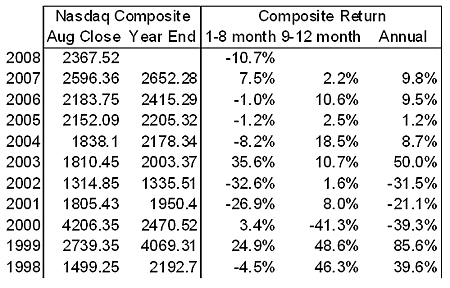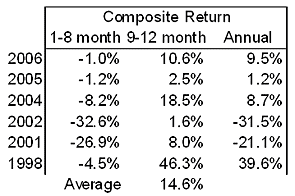The stocks to buy now for a Christmas bonus
As financial stocks are taking a hammering, it might be good to take a look at another bombed-out sector – tech stocks. It's round about now that the Nasdaq often embarks on an end-of-year rally. If history is any guide at all, you could beat the market by almost 15%.
Well, we're about two-thirds of the way through 2008 - a year that could potentially be the worst one for stocks since 2002.
As you may know - and as we've mentioned here many times before - the best time to buy is when the investment world is at its most fearful and when the overriding investor sentiment is 'panic'.
But what does history tell us? Is it time to camp out in cash-based investments, or look for stock bargains?
Subscribe to MoneyWeek
Subscribe to MoneyWeek today and get your first six magazine issues absolutely FREE

Sign up to Money Morning
Don't miss the latest investment and personal finances news, market analysis, plus money-saving tips with our free twice-daily newsletter
Don't miss the latest investment and personal finances news, market analysis, plus money-saving tips with our free twice-daily newsletter
The following statistics help paint an interesting picture, which shows that investors could benefit by simply buying one particular market index into the end of the year
Tech primed for another strong stretch run
I've reviewed the Nasdaq Composite index's returns over the past ten years in two different time segments: The first eight months of the year and the last four months of the year.
If history is any guide, it shows that a year-end rally is likely and offers clues as to where investors should look to put their money to work.

As you can see, technology firms are particularly likely to enjoy an end-of-year rally, as corporate IT managers spend any budget dollars set aside for the year to that point, and online advertising and commerce companies benefit from the shift toward online retail and away from traditional retailers.
Let's break down the numbers
The end-of-year tech rally
Right now, the Nasdaq Composite index is down about 11% on the year. But history shows that this trend doesn't necessarily continue until the end of the year.

As you can see, there have been six instances over the past 10 years where the Nasdaq Composite's returns over the first eight months of the year were negative.
But on all six occasions, the index promptly rallied into the end of the year. Not only were the returns positive, they were impressive, notching up an average of 14.6%.
This unusual occurrence could be due to several factors
The benefit of stocks being oversold
Optimism about the coming year
The expectation for outperformance as companies experience budget flush
Fund managers putting more capital to work in order to aggressively chase year-end performance
Regardless of the cause, a correlation exists. And here's how you can take advantage
15% gains from the last four months
In a post tech-bubble economy, by being invested in the sector over the final four months of the year, rather than throughout the entire year, you could outperform the market by 15%.
This may be a short period to draw conclusions from but it represents a solid view of a stable environment for investing in technology stocks.
The years of the bubble, crash, and the first year of recovery misrepresent the growth prospects of the environment we're in today. And the numbers clearly show that the potential for negative returns are in the early part of the year, when companies have less visibility into financial results, drags on the overall performance.
Therefore, you could outperform the market by buying the index on the first trading day of September and selling at the end of the year. In the post tech bubble/recovery era, this strategy would result in the individual outperforming the market by 15.1%.
Since I wrote about technology stocks coming under pressure from the appreciating dollar, in my last column on August 26, the Nasdaq Composite has dropped 5.7%. This has taken down the stocks to own, as well as those vulnerable to earnings revisions.
Considering the relative stability of technology companies that are independently diversified by not being levered to a single-end market, plus the historical seasonal support, we're looking for an opportunity to begin to put money to work - and I intend to do just that.
This article was written by Paul Moore, and was first published in the Smart Profits Report on 11 September
Get the latest financial news, insights and expert analysis from our award-winning MoneyWeek team, to help you understand what really matters when it comes to your finances.
MoneyWeek is written by a team of experienced and award-winning journalists, plus expert columnists. As well as daily digital news and features, MoneyWeek also publishes a weekly magazine, covering investing and personal finance. From share tips, pensions, gold to practical investment tips - we provide a round-up to help you make money and keep it.
-
 High earners underestimate how much they need to retire comfortably
High earners underestimate how much they need to retire comfortablyHigh net worth individuals grossly misjudge how much money they need for a comfortable retirement, new data shows, with many not saving enough.
-
 Retired banker who gave wife £80m to avoid inheritance tax won’t face equal split in divorce
Retired banker who gave wife £80m to avoid inheritance tax won’t face equal split in divorceFamily lawyers say the Supreme Court ruling will have significant impact on high net worth divorce cases

